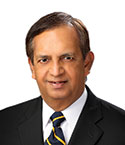|
Look, ma! I’ve come up with an equation that governs economic growth. I dream up such off-the-wall concepts between 4 and 5 a.m. U.S. Republican presidential candidate Rick Santorum would perhaps attribute this to divine inspiration. Sigmund Freud would probably point to a psychological disorder or blame my mother. What my equation lacks is academic flourish. I’ll have to outsource this task to a top-flight, low-cost think tank to sprinkle some exponents and integral functions, to add just enough obfuscation to confuse even Nobel Laureate and Energy Secretary Paul Chu. Here is an explanation of the variables involved in this equation with examples from our oil and gas industry. Incentive. I am not likely to get an argument about this variable—economic incentive. It is this factor that has fueled the shale gas revolution. When natural gas prices were at $10/Mcf and the U.S. was expected to be a major market for LNG imports, there was plenty of economic incentive for intrepid independent operators to increase revenues through technological innovations, such as horizontal drilling and multi-stage fracturing. Now that gas prices have dropped to $2.50/Mcf, there is a substantial downturn in drilling activity. On the other hand, the uptick in oil-directed drilling is a consequence of the economic incentive provided by oil prices climbing above $100/bbl. Faith. What I call “faith-based E&P” is activity that is conducted, even when there is insufficient economic incentive. For example, while companies such as Chesapeake, are downsizing their dry gas activity, ExxonMobil has vowed to continue all of its gas operations, based on the company’s “faith” that the current drop in gas prices is a short-term phenomenon. The major oil company believes the long-term fundamentals will lead to higher natural gas prices in the near future. Another example is the Obama administration’s “faith” in the future of renewable resources in the absence of an economic incentive. Billions have been spent on new solar and wind projects before an incentivized market has emerged for these high-priced and still-evolving energy sources. Still another example would be that of a state-directed NOC that will have as its operating tenet—full employment for its workers — in spite of negative economic conditions. Momentum. This is the variable that has a significant impact on growth. The best example of momentum is the mushrooming of shale plays in North America. The Barnett is the granddaddy of U.S. shale plays and how quickly the shale family has grown—Marcellus, Haynesville, Bakken and Eagle Ford. Two years ago, World Oil decided to cover the shale plays in alternating months. This year, we doubled the coverage to 12 plays, one per month. With the continuing emergence of new plays, such as the Mississippi Lime and the recent USGS assessment of both shale oil and shale gas in Alaska, we are at a point of asking the Earth to slow down its rotation around the Sun so that we can have at least 15 months in a year. An example of a downward shift in momentum is the activity in the Gulf of Mexico. Prior to the Macondo spill, drilling and production operations had reached a recent high. The Perdido spar had just started production, the industry was moving ahead on exploring the Lower Tertiary plays, and there was even excitement about shallow-water potential with the discovery of the Davy Jones prospect by McMoran. The Obama administration disrupted this momentum with a six-month moratorium and the subsequent permitorium. It will take some time before we are able to return to the pre-Macondo optimism and enthusiasm. Such is the stuff my dreams are made of. Are there any oil and gas psychoanalysts around? |

- Prices and governmental policies combine to stymie Canadian upstream growth (February 2024)
- U.S. producing gas wells increase despite low prices (February 2024)
- U.S. drilling: More of the same expected (February 2024)
- U.S. oil and natural gas production hits record highs (February 2024)
- U.S. upstream muddles along, with an eye toward 2024 (September 2023)
- Canada's upstream soldiers on despite governmental interference (September 2023)
- Applying ultra-deep LWD resistivity technology successfully in a SAGD operation (May 2019)
- Adoption of wireless intelligent completions advances (May 2019)
- Majors double down as takeaway crunch eases (April 2019)
- What’s new in well logging and formation evaluation (April 2019)
- Qualification of a 20,000-psi subsea BOP: A collaborative approach (February 2019)
- ConocoPhillips’ Greg Leveille sees rapid trajectory of technical advancement continuing (February 2019)


